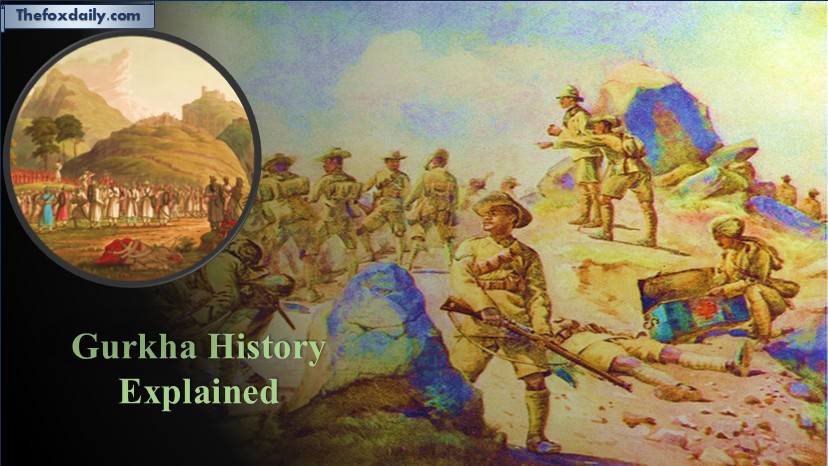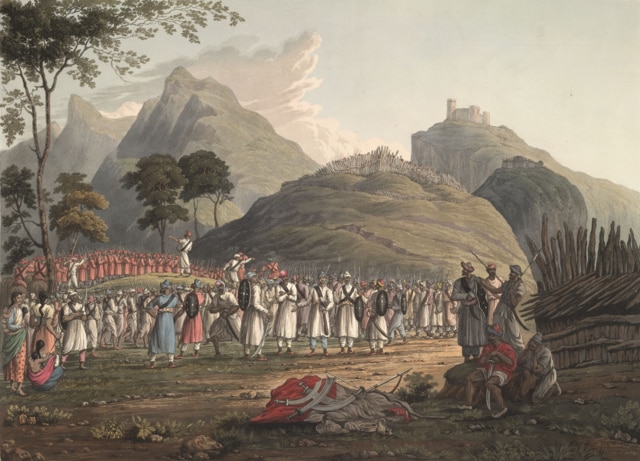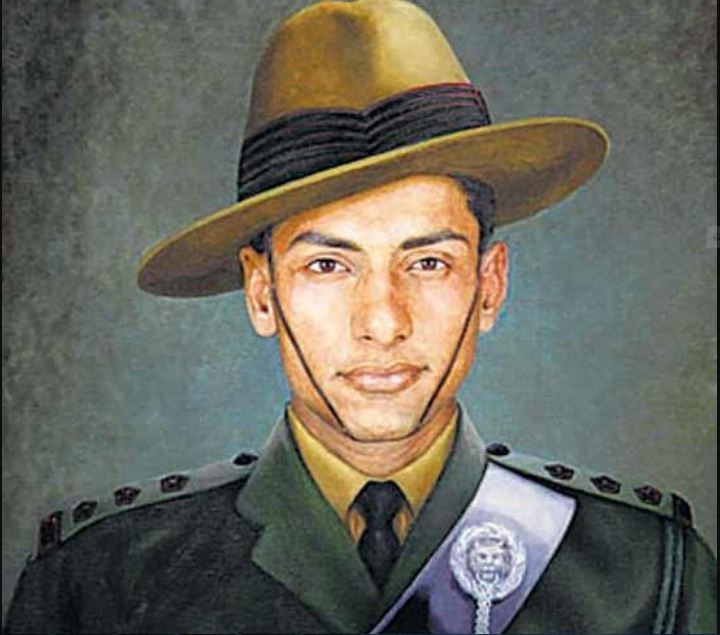
- The Origins: How the Gurkhas Entered the British Indian Army
- The Rise of the Gurkhas
- The Anglo-Nepalese War (1814–1816)
- The Birth of the Gurkha Regiments
- The Gurkhas in the Rebellion of 1857 and Beyond
- Post-Independence and the Tripartite Agreement
- The Gurkhas in the Kargil War
- The Gurkhas Today: Legacy and Valor
“If someone says he has no fear, either he is lying or he is a Gurkha.”
This legendary remark by Field Marshal Sam Manekshaw perfectly captures the spirit of the Gurkhas – soldiers whose discipline, devotion, and unmatched bravery have defined over two centuries of military excellence. Their traditional weapon, the Khukri – an 18-inch curved knife – remains a symbol of valor and honor. Tradition holds that once drawn, a khukri must taste blood before returning to its sheath, even if it means the warrior cuts himself.
The Gurkhas live by the immortal motto: “Better to die than be a coward.” According to historian Byron Farwell in his book The Gurkhas, the name “Gurkha” comes from “Gau” (cow) and “Rakh” (protector), meaning “protector of the cow.”
From the 1947–48 War and 1971 Liberation War to the Kargil War of 1999, the Gurkhas have been among India’s most decorated and respected regiments. During Kargil, Colonel Lalit Rai and his men showed extraordinary courage – famously giving the six-foot Pathans a “bloody nose.” The Gurkhas’ fierce close-combat prowess was again on display when they used their Khukris in the freezing Batalik heights to overpower enemy positions.
The Origins: How the Gurkhas Entered the British Indian Army
Few realize that the Gurkha Regiment was not originally part of the British Indian Army. Their path from foes to brothers-in-arms began after the Anglo-Nepalese War (1814–1816). Despite being poorly armed, the Gurkhas’ ferocity impressed the British. During the Victorian era, the British classified them as a “martial race” – resilient, loyal, and naturally skilled warriors.

The Rise of the Gurkhas
According to legend, the Gurkhas trace their origins to the 10th century CE during Nepal’s Malla dynasty, when the region consisted of small hill kingdoms. One of these, Gorkha, lay northwest of Kathmandu. From here, in 1742, King Prithvi Narayan Shah began unifying Nepal, extending its borders west to Kumaon and Garhwal and east to Sikkim. By the late 18th century, Nepal’s influence stretched almost to modern-day Shimla.
As Nepal expanded, it came into conflict with the British East India Company, sparking a war that would shape South Asian military history forever.
The Anglo-Nepalese War (1814–1816)

The British launched war in 1814 to push the Gorkhas out of disputed territories. But they soon learned that their real challenge was not the terrain – it was the indomitable Gurkha warriors. Despite using outdated muskets, the Nepalese troops fought fearlessly from the mountains, wielding their Khukris with deadly precision.
British officer Ensign John Shipp later wrote: “In my life, I have never witnessed such bravery or steadiness. They refused to flee and appeared unafraid of dying.”
Ultimately, superior British numbers and weaponry prevailed, and in 1816 the Treaty of Sugauli was signed. Nepal lost territories like Garhwal and Kumaon – but the treaty’s most significant clause allowed the British to recruit Nepali soldiers into their army, forging a unique bond that continues to this day.
The Birth of the Gurkha Regiments

British officers, deeply impressed by the Gurkhas’ loyalty and resilience, began recruiting them immediately. Lieutenant Frederick Young formed the first Gurkha unit – the Sirmoor Battalion – in 1815 at Dehradun, even before the war ended. This later became the 2nd King Edward VII’s Own Gurkha Rifles.
Simultaneously, the Kumaon Battalion was raised at Almora (later the 3rd Gurkhas), and the Nasiri Battalion at Subathu (the 1st Gurkha Rifles). Over time, these regiments became some of the most trusted and decorated units in the British Indian Army.
| Year | Event | Outcome |
|---|---|---|
| 1814–1816 | Anglo-Nepalese War | British impressed by Gurkhas’ bravery |
| 1815 | Formation of Sirmoor Battalion | First Gurkha unit in British Indian Army |
| 1816 | Treaty of Sugauli | British gain right to recruit Gurkhas |
| 1947 | Partition of Gurkha Regiments | Six regiments join Indian Army, four remain British |
The Gurkhas in the Rebellion of 1857 and Beyond

When the Indian Rebellion of 1857 erupted, most Gurkha regiments remained loyal to the British. Their steadfast defense during the Siege of Lucknow helped the British retain control over India. Later, Gurkha troops fought bravely in the Boxer Rebellion (1900) and the Tibetan Expedition (1904).
During World War I, over 200,000 Gurkhas served in the British Army, fighting across Europe, the Middle East, and Asia. More than 20,000 were killed or wounded, and nearly 2,000 received awards for valor. Their numbers doubled during World War II, where they became legendary in the Burma and Malaya campaigns. Among them was a young officer named Sam Manekshaw – India’s future Field Marshal.
Post-Independence and the Tripartite Agreement
After India’s independence in 1947, the Tripartite Agreement between India, Britain, and Nepal divided the ten Gurkha regiments. Four went to the British Army, while six became part of the Indian Army. The 1st, 3rd, 4th, 5th, 8th, and 9th Gurkha Rifles remained with India, while the 11th Gorkha Rifles was re-raised in 1948 at Palampur and Mumbai.
Since then, Gurkhas have played vital roles in every major Indian military campaign – from the 1967 Nathu La and Cho La clashes with china to the 1971 Bangladesh Liberation War, where their discipline during the Meghna heli-bridge operation earned them the Sena Medal and Vir Chakra.
The Gurkhas in the Kargil War
During the Kargil War (1999), the 1st Battalion of the 11 Gorkha Rifles was among the first deployed to the high-altitude battlefields. Under Colonel Lalit Rai’s command, they captured critical peaks like Khalubar and Kukarthang under intense enemy fire. Captain Manoj Kumar Pandey led his men despite grave injuries and was posthumously awarded the Param Vir Chakra, India’s highest gallantry honor.
The battalion received multiple distinctions, including the Battle Honour Batalik and Theatre Honour Kargil, becoming one of the few regiments with both Param Vir Chakra and Ashok Chakra recipients.
Japanese officer Yuji, who fought the Gurkhas during World War II, once said: “The Gurkhas were transparently honest men – brave, disciplined, and simple soldiers – the very model of integrity.”
The Gurkhas Today: Legacy and Valor
Today, over 30,000 Gurkha soldiers serve in the Indian Army, continuing a legacy of loyalty, courage, and sacrifice. The Khukri remains not just a weapon, but a sacred symbol of their readiness, pride, and heritage – an eternal reminder of their timeless motto: “Better to die than be a coward.”
For breaking news and live news updates, like us on Facebook or follow us on Twitter and Instagram. Read more on Latest Education on thefoxdaily.com.

COMMENTS 0